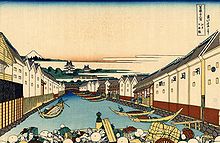Fudasashi

The traders at the rice markets in Edo and Osaka were referred to as Fudasashi ( Japanese 札 差 ) . Edo was the Japanese capital from 1603 . Kuramae , the market in front of the rice granaries in Asakusa, was the center of the Japanese economy in the Edo period , because all daimyō (princes) received most of their taxes in kind, namely rice. After the rice yield in koku , the value of their lands was also measured. The daimyō's duties to the Shogun were brought to Edo, mostly by ship, where they were sold on that same rice market.
Over the years, something developed on the rice market that is modernly referred to as commodity futures business : the daimyo cultivated a dissolute lifestyle. When cash ran out, they made deals with traders for future crops. In the second half of the Edo period, many daimyo were in debt, which led the shoguns to cancel the debts of the feudal lords by decree on several occasions.
etymology
札 fuda is a change, i.e. a bank note, 差 す sasu here means offer or spend. A 札 差 is someone who issues bills of exchange on the rice.